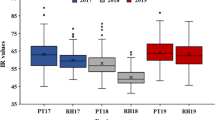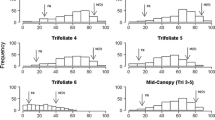Abstract
As water demand for agriculture exceeds water availability, cropping systems need to become more efficient in water usage, such as deployment of cultivars that sustain yield under drought conditions. Soybean cultivars differ in how quickly they wilt during water-deficit stress, and this trait may lead to yield improvement during drought. The objective of this study was to determine the genetic mechanism of canopy wilting in soybean using a mapping population of recombinant inbred lines (RILs) derived from a cross between KS4895 and Jackson. Canopy wilting was rated in three environments using a rating scale of 0 (no wilting) to 100 (severe wilting and plant death). Transgressive segregation was observed for the RIL population with the parents expressing intermediate wilting scores. Using multiple-loci analysis, four quantitative trait loci (QTLs) on molecular linkage groups (MLGs) A2, B2, D2, and F were detected (P ≤ 0.05), which collectively accounted for 47% of the phenotypic variation of genotypic means over all three environments. An analysis of the data by state revealed that 44% of the observed phenotypic variation in the Arkansas environments could be accounted for by these QTLs. Only the QTL on MLG F was detected at North Carolina where it accounted for 16% of the phenotypic variation. These results demonstrate that the genetic mechanism controlling canopy wilting was polygenic and environmentally sensitive and provide a foundation for future research to examine the importance of canopy wilting in drought tolerance of soybean.


Similar content being viewed by others
References
Blair MW, Pedraza F, Buendía HF, Gaitan-Solís E, Beebe SE, Gepts P, Tohme J (2003) Development of a genome-wide anchored microsatellite map for common bean (Phaseolus vulgaris L.). Theor Appl Genet 107:1362–1374
Bouck A, Peeler R, Arnold ML, Wessler SR (2005) Genetic mapping of species boundaries in Louisiana irises using IRRE retrotransposons display markers. Genetics 171:1289–1303
Carter TE, DeSouza PI, Purcell LC (1999) Recent advances in breeding for drought and aluminum resistance in soybean. In Hauffman HE (ed) Proc World Soybean Res Conf VI. Superior Printing, Champaign, IL
Choi I-Y, Hyten DL, Matukumalli LK, Song Q, Chaky JM, Quigley CV, Chase K, Lark KG, Reiter RS, Yoon M-S, Hwang E-Y, Yi S-I, Young ND, Shoemaker RC, van Tassell CP, Specht JE, Cregan PB (2007) A soybean transcript map: gene distribution, haplotype and single-nucleotide polymorphism analysis. Genetics 176:685–696
Diers BW, Keim P, Fehr WR, Shoemaker RC (1992) RFLP analysis of soybean seed protein and oil content. Theor Appl Genet 83:608–612
Dong Y, Ogawa T, Lin D, Koh H-J, Kamiunten H, Matsuo M, Cheng S (2005) Molecular mapping of quantitative trait loci for zinc toxicity tolerance in rice seedling (Oryza sativa L.). Field Crops Res 95:420–425
Fehr WR (1987) Principles of cultivar development: theory and practice. Macmillian Publishing Company, New York, pp 95–105
Fehr WR, Caviness CE (1977) Stages of soybean development. Iowa Cooperative Extension Service, Iowa Agricultural and Home Economics Experiment Station: Special Report 80
Fletcher AL, Sinclair TR, Allen LH (2007) Transpiration responses to vapor pressure deficit in well watered ‘slow-wilting’ and commercial soybean. Environ Exp Bot 61:145–151
Hollowell EA (1958) Registration of soybean varieties, IV. Agro J 50:691–699
Hyten DL, Pantalone VR, Sams CE, Saxton AM, Landau-Ellis D, Stefaniak TR, Schmidt ME (2004) Seed quality QTL in a prominent soybean population. Theor Appl Genet 109:552–561
IPCC (2001) Climate change 2001: the scientific basis. In: Houghton JT, Ding Y, Griggs DJ, Noguer M, van der Linden PJ, Xiaosu D (eds) Contribution of working group I to the third assessment report of the inter-governmental panel on climate change (IPCC). Cambridge University, Cambridge, UK Press
Kaldenhoff R, Fischer M (2006) Aquaporins in plants. Acta Physiol 187:169–176
Kassem MA, Shultz J, Meksem K, Cho Y, Wood AJ, Iqbal MJ, Lightfoot DA (2006) An updated ‘Essex’ by ‘Forest’ linkage map and first composite interval map of QTL underlying six soybean traits. Theor Appl Genet 113:1015–1026
King CA, Purcell LC, Brye KR (2009) Differential wilting among soybean genotypes in response to water deficit. Crop Sci 49:290–298
Lander ES, Green P, Abrahamson J, Barlow A, Daly MJ, Lincoln SE, Newburg L (1987) Mapmaker: an interactive computer package for constructing primary genetic linkage maps of experimental and natural populations. Genomics 1:174–181
Lawlar DW, Cornic G (2002) Photosynthetic carbon assimilation and associated metabolism in relation to water deficits in higher plants. Plant Cell Environ 25:275–294
Lee SH, Bailey MA, Mian MAR, Carter TE, Shipe ER, Ashley DA, Parrott WA, Hussey RS, Boerma HR (1996) RFLP loci associated with soybean seed protein and oil content across populations and locations. TAG 93:649–657
Mienie CMS, Fourie H, Smit MA, Van Staden J, Botha FC (2002) Identification of AFLP markers in soybean linked to resistance to Meloidogyne javanica and conversion to sequence characterized amplified regions (SCARs). Plant Growth Reg 37:157–166
O’Toole JC, Moya TB (1978) Genotypic variation in maintenance of leaf water potential in rice. Crop Sci 18:873–876
Orf JH, Chase K, Jarvik T, Mansur LM, Cregan PB, Adler FR, Lark KG (1999) Genetics of soybean agronomic traits. I. Comparison of three related recombinant inbred populations. Crop Sci 39:1642–1651
Panthee DR, Pantalone VR, West DR, Saxton AM, Sams CE (2005) Quantitative trait loci for seed protein and oil concentration, and seed size in soybean. Crop Sci 45:2015–2022
Carter TE, Orf JH, Purcell, LC, Specht JE, Chen P, Sinclair TR, Rufty TW (2006) Tough times, tough plants-new soybean genes defend against drought and other stress. In: Proc 33rd Soybean Seed Res Conf Am Seed Trade Assoc. Alexandria, VA
Purcell LC, deSilva M, King CA, Kim WH (1997) Biomass accumulation and allocation in soybean associated with genotypic differences in tolerance of nitrogen fixation. Plant Soil 196:101–113
Rahi GS, Rich JR, Hodge C (1988) Effect of Meloidogyne incognita and M. javanica on leaf water potential and water use of tobacco. J Nematol 20:516–522
Rector BG, All JN, Parrott WA, Boerma HR (2000) Quantitative trait loci for antibiosis resistance to corn earworm in soybean. Crop Sci 40:233–238
Reyna N, Sneller CH (2001) Evaluation of marker-assisted introgression of yield QTL alleles into adapted soybean. Crop Sci 41:1317–1321
Schapaugh WT, Dille RE (1998) Registration of ‘KS4694’ soybean. Crop Sci 38:891
Shultz JL, Ray JD, Smith JR, Mengistu A (2007) A soybean mapping population specific to the early soybean production system. DNA Seq 18:104–111
Sloane RJ, Patterson RP, Carter TE (1990) Field drought tolerance of a soybean plant introduction. Crop Sci 30:118–123
Song Q, Marek LF, Shoemaker RC, Lark KG, Concibido VC, Delannay X, Specht JE, Creagon PB (2004) A new integrated genetic linkage map of the soybean. Theor Appl Genet 109:122–128
Wang S, Basten CJ, Zeng ZB (2007) Windows QTL Cartographer 2.5. Department of Statistics, North Carolina State University, Raleigh, North Carolina
Yamanaka N, Ninomiya S, Hoshi M, Tsubokura Y, Yano M, Nagamura Y, Sasaki T, Harada K (2001) An informative linkage map of soybean reveals QTLs for flowering time, leaflet morphology and regions of segregation distortion. DNA Res 8:61–72
Acknowledgments
The authors gratefully appreciate the financial support from the United Soybean Board (Project #5213). Also, we would like to thank the University of Arkansas Rice Research and Experiment Station, Sandhills Research Station at North Carolina, and USDA-ARS Midsouth Area Genomics Facility at Stoneville, MS for provided resources. We also extend our thanks to Dr. Pengyin Chen of the University of Arkansas for his insightful comments and suggestions during the preparation of this manuscript.
Author information
Authors and Affiliations
Corresponding author
Additional information
Communicated by F. Muehlbauer.
Rights and permissions
About this article
Cite this article
Charlson, D.V., Bhatnagar, S., King, C.A. et al. Polygenic inheritance of canopy wilting in soybean [Glycine max (L.) Merr.]. Theor Appl Genet 119, 587–594 (2009). https://doi.org/10.1007/s00122-009-1068-4
Received:
Accepted:
Published:
Issue Date:
DOI: https://doi.org/10.1007/s00122-009-1068-4




